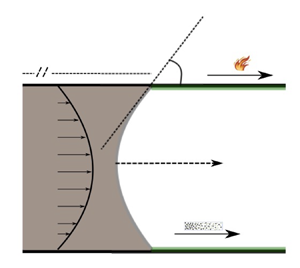Article contents
Examining capillary dynamics in rectangular and circular conduits subject to unsteady surface tension
Published online by Cambridge University Press: 23 September 2022
Abstract

The unsteady effects of transitioning surface tension,  $\gamma (t)$, on the dynamics of capillary imbibition in channels of arbitrary shape are analytically investigated with a focus on rectangular and circular channels. With proper scaling, two unsteady models for
$\gamma (t)$, on the dynamics of capillary imbibition in channels of arbitrary shape are analytically investigated with a focus on rectangular and circular channels. With proper scaling, two unsteady models for  $\gamma (t)$ are defined and used to highlight this transient behaviour. The convoluted dynamics at the flow front are correctly captured in the governing equations, which are rigorously analysed using unsteady eigenfunction expansion. Then, the final solution and data are obtained by employing the Runge–Kutta fourth-order scheme elegantly applied simultaneously to two derived nonlinear ordinary differential equations. Ultimately, the results are more accurate compared with previous studies. Dynamics and kinematic similarity between rectangular and circular channels are investigated and discussed and the conditions for equivalence in both channels are highlighted. Using a small parameter (
$\gamma (t)$ are defined and used to highlight this transient behaviour. The convoluted dynamics at the flow front are correctly captured in the governing equations, which are rigorously analysed using unsteady eigenfunction expansion. Then, the final solution and data are obtained by employing the Runge–Kutta fourth-order scheme elegantly applied simultaneously to two derived nonlinear ordinary differential equations. Ultimately, the results are more accurate compared with previous studies. Dynamics and kinematic similarity between rectangular and circular channels are investigated and discussed and the conditions for equivalence in both channels are highlighted. Using a small parameter ( $\epsilon$) that stretches the time scale, we successfully use a robust asymptotic analysis to develop and capture the long-time dynamics. Ultimately, we recover the Lucas–Washburn regime analysed in Washburn (Phys. Rev., vol. 17, 1921, pp. 273–283), Lucas (Kolloidn. Z., vol. 23, 1918, pp. 15–22) for steady surface tension where the variations of depth and rate with time result in
$\epsilon$) that stretches the time scale, we successfully use a robust asymptotic analysis to develop and capture the long-time dynamics. Ultimately, we recover the Lucas–Washburn regime analysed in Washburn (Phys. Rev., vol. 17, 1921, pp. 273–283), Lucas (Kolloidn. Z., vol. 23, 1918, pp. 15–22) for steady surface tension where the variations of depth and rate with time result in  $h\thicksim t^{1/2}$ and
$h\thicksim t^{1/2}$ and  $v \thicksim t^{-1/2}$. In the end, the three forces, namely the inertia,
$v \thicksim t^{-1/2}$. In the end, the three forces, namely the inertia,  $F_{v}$, the viscous,
$F_{v}$, the viscous,  $F_{\mu }$, and the surface tension,
$F_{\mu }$, and the surface tension,  $F_{\gamma }$, are briefly analysed and used to highlight three main distinct regimes. We show that at early times,
$F_{\gamma }$, are briefly analysed and used to highlight three main distinct regimes. We show that at early times,  $F_{v}/F_{\gamma } \thicksim 1$, whereas at a long time,
$F_{v}/F_{\gamma } \thicksim 1$, whereas at a long time,  $F_{\mu }/F_{\gamma } \thicksim -1$.
$F_{\mu }/F_{\gamma } \thicksim -1$.
- Type
- JFM Papers
- Information
- Copyright
- © The Author(s), 2022. Published by Cambridge University Press
References
REFERENCES
- 2
- Cited by





